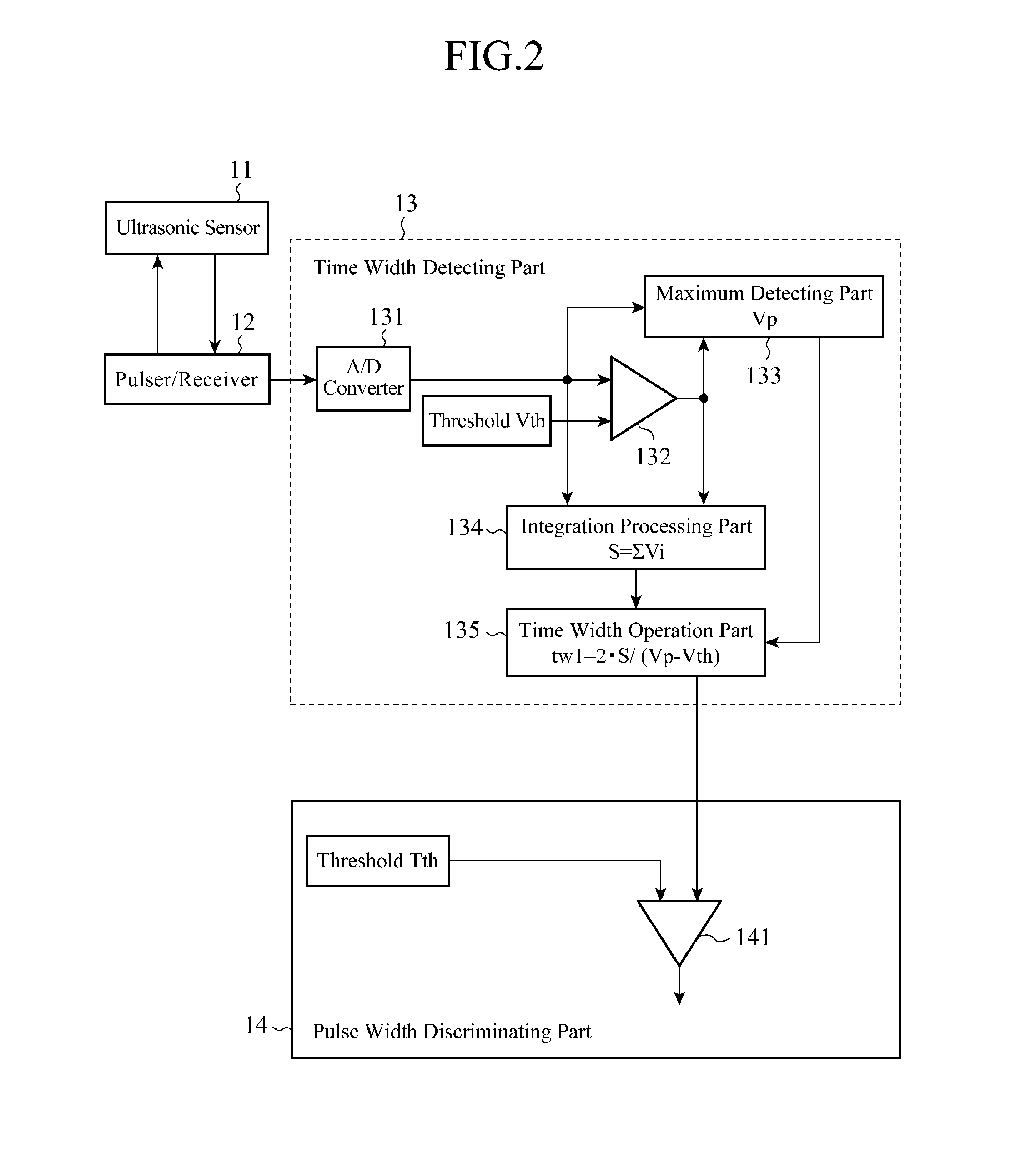Ultrasonic detection device
- Summary
- Abstract
- Description
- Claims
- Application Information
AI Technical Summary
Benefits of technology
Problems solved by technology
Method used
Image
Examples
embodiment 1
[0019]FIG. 1 is a view showing the principle behind noise discrimination carried out by an ultrasonic detection device in accordance with this Embodiment 1. In FIG. 1(a), the waveforms of a transmission pulse transmitted by and a reception pulse received by a pulser / receiver disposed in the ultrasonic detection device in accordance with this Embodiment 1. In FIG. 1(b), an area S, a maximum amplitude Vp, and an amplitude threshold Vth which are parameters used when computing a pulse time width tw1 are shown in the waveform of a signal which is a reflected wave signal or a noise.
[0020]For example, the ultrasonic detection device in accordance with this Embodiment 1, which can be used as a corner sensor of a vehicle, transmits an ultrasonic pulse toward an object from the pulser thereof, and receives a reflection signal from the object by using the receiver thereof. It is known that a noise component including an electromagnetism noise, a noise caused by a whizzing sound, a noise cause...
embodiment 2
[0036]FIG. 3 is a view showing the principle behind noise discrimination carried out by an ultrasonic detection device in accordance with this Embodiment 2, and FIG. 4 is a block diagram showing the structure of the ultrasonic detection device in accordance with this Embodiment 2.
[0037]As can be seen from FIG. 3, the ultrasonic detection device in accordance with this embodiment differs from that in accordance with Embodiment 1 shown in FIG. 1(b) in that after approximating the waveform of a reflected wave S (a noise n) as an isosceles triangle, like that of Embodiment 1, further determines a similar isosceles triangle from a similarity expression of the isosceles triangle, and determines the length of the base of the similar isosceles triangle, i.e., the pulse time width tw2 of each of the reflection signal and the noise n according to the following computing equation (2). A noise discriminating process of discriminating between the reflected wave S and the noise n by determining w...
embodiment 3
[0040]FIG. 5 is a view showing the principle behind noise discrimination carried out by an ultrasonic detection device in accordance with this Embodiment 3, and FIG. 6 is a block diagram showing the structure of the ultrasonic detection device in accordance with this Embodiment 3.
[0041]Reflection signals S1 to S3 which are received at predetermined times (En0, En1, and En2) in synchronization with ultrasonic pulses transmitted by a pulser / receiver 12 in the ultrasonic detection device in accordance with this Embodiment 3 are shown in time sequence in FIGS. 5(a) to 5(c), respectively. FIG. 5(d) shows a signal component St which is acquired by combining (adding up) the reflection signals S1 to S3 respectively received at the times En0, En1, and En2.
In FIG. 5(d), tw1i shows the pulse time width of the reflection signal St which is acquired by combining (adding up) the reflection signals S1 to S3.
[0042]In this embodiment, the ultrasonic detection device performs a noise discriminating p...
PUM
 Login to View More
Login to View More Abstract
Description
Claims
Application Information
 Login to View More
Login to View More - R&D
- Intellectual Property
- Life Sciences
- Materials
- Tech Scout
- Unparalleled Data Quality
- Higher Quality Content
- 60% Fewer Hallucinations
Browse by: Latest US Patents, China's latest patents, Technical Efficacy Thesaurus, Application Domain, Technology Topic, Popular Technical Reports.
© 2025 PatSnap. All rights reserved.Legal|Privacy policy|Modern Slavery Act Transparency Statement|Sitemap|About US| Contact US: help@patsnap.com



